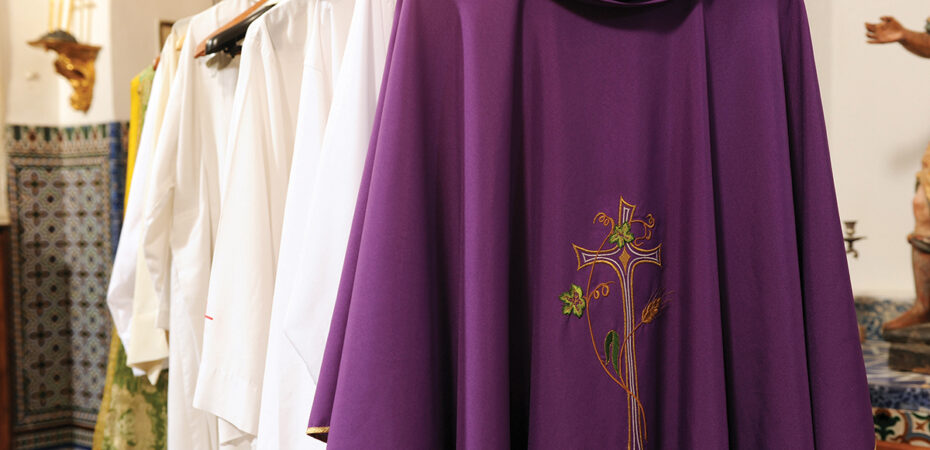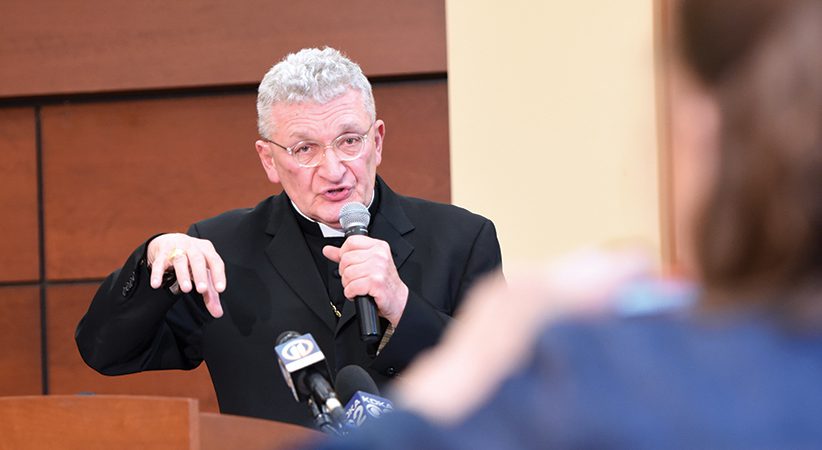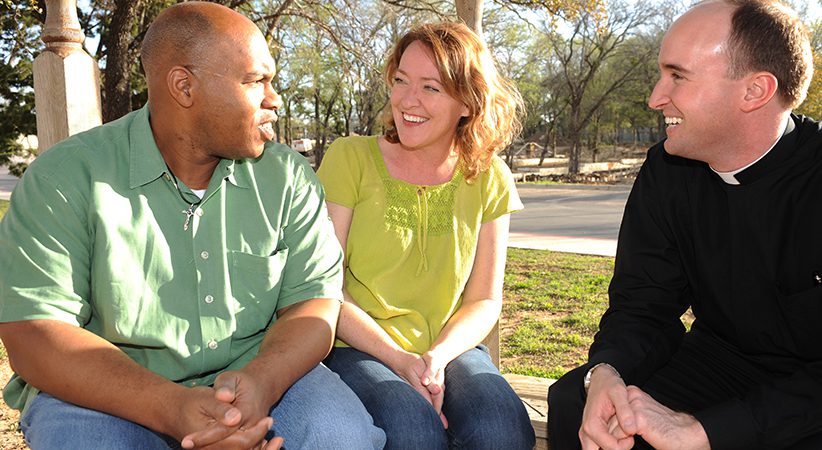Resolutions for the New (Liturgical) Year
Prepare with these practical and sound tips
Father Ronald D. Witherup Comments Off on Resolutions for the New (Liturgical) Year
New Year’s resolutions. They are not my favorite, mostly because — to be honest — I am not very good at keeping them. But why should we be concerned with these when Jan. 1 is almost two months away?
For us presbyters, of course, the “new year” that looms is the new liturgical year, which starts Dec. 3, the First Sunday of Advent. How might we prepare for this new beginning with some practical and sound resolutions?
While it may be surprising, the origin of New Year’s resolutions is not a modern invention. One can trace it to a religious foundation both in ancient Roman society and biblical times. The Romans of antiquity, who were superstitious and fearful of provoking the ire of their gods, resolved every January (the month’s name comes from the god Janus) to begin a new year with better aspirations and goals.
From a Jewish perspective, the idea of resolutions mostly centered around the annual feast of Rosh Hashanah (New Year), which began the High Holidays that culminated in Yom Kippur (the Day of Atonement). This ancient biblically inspired practice continues today. The explicitly religious orientation is to divest oneself of misdeeds from the past year by an admission of guilt and a resolve to do better in the coming year.
In today’s American society, recent statistics show that about 40% of Americans practice some form of secular New Year’s resolutions on Jan. 1. The success rate of putting these resolutions into practice is, not surprisingly, perhaps 30%. The most serious obstacle to creating a successful list of resolutions is that people set the bar too high for themselves. Honorable goals become unrealistic and unachievable. We need only think of how often that new gym membership in January — after the holiday feasting ends — slowly fades into the background with the demands of the new year.
Most importantly, the practice of resolutions at the beginning of the year is rooted in a recognition that our recent past has not always been a stellar success. We desire to do better when a new year dawns. It is not difficult to see how well this perspective coincides with our Christian practice of repentance, penance and forgiveness. Resolutions are a means to start afresh. They offer hope that we can, and will, do better with God’s gift of a new year.
For the Liturgical Year
I suggest the following as possible resolutions for priests for the liturgical year about to begin, evoking the great biblical tradition of “seven” as the perfect number,
Resolution 1: Take the Long View
View the new liturgical year in its entirety. What is reasonable and doable for us as presbyters throughout the whole year? What planning can we initiate to ensure that, step-by-step, we attempt to improve our ministerial style throughout the whole year? In particular, are there ways to promote better coordination with parish staff, other ministers of the parish and volunteers? Can we enhance the way we welcome parishioners and outsiders at worship or parish events? Can we perhaps initiate an outreach to those whose faith commitment has wavered, especially in the face of the recent challenges of the COVID-19 pandemic and its aftermath? Do we even prepare our liturgical vestments properly, ensuring they are properly laundered and ready for use throughout the year?
Resolution 2: Honor the Integrity of the Liturgical Season
As readers know well, the Church’s liturgical year has its own integrity. It unfolds from Advent, to the Christmas season, to Ordinary Time, through Lent and Easter, and culminates at the end of the remaining weeks of Ordinary Time with the solemnity of Christ the King. Various memorials, feasts and solemnities punctuate this rhythm. Intentionally, there are penitential periods and times of intense jubilation. There are somber and celebratory moods.
Since the Second Vatican Council, there is also the practice of alternating three liturgical years (A, B, C) with, respectively, the synoptic Gospels of Matthew, Mark and Luke. The Gospel of John is used mostly in the Lenten and Easter seasons, with important cameos during the Christmas season. The main point here is that the year is not simply a bland unfolding of the Faith, Sunday after Sunday, week after week. The liturgical year is meant to invoke high points and low points, mountains and valleys, which help our people reflect on how God is at work in their daily lives. Respecting this rhythm means not simply harmonizing the Gospels, or blithely regurgitating old lessons learned decades ago in our seminary days.
The liturgical year about to begin is the Year of Mark (B). To take this seriously, we should take a closer look at this Gospel in toto and try to get into the unique way it tells the story of Jesus Christ (see sidebar). This can inform on how we preach during its appearances throughout the year, as well as give us a larger perspective on how this Gospel might relate to our daily lives.
……………………………………………………………………………………………………………………………………………..
Mark: The Lion
The Gospel of Mark is the shortest of the Gospels. In practice, for the liturgical year, this means it ends up being supplemented by other Gospel passages, mostly from John. This fact aside, it is helpful to review some chief characteristics of Mark.
By ancient tradition, Mark is symbolized by the “lion” (cf. Rv 4:7). This is most appropriate, since Mark is truly a powerful and noble Gospel, presenting the narrative of Jesus Christ, Son of God, in a fast-paced narration from the ministry of John the Baptist to Jesus’ death on a cross and subsequent resurrection. Here is a short list of some major aspects of Mark to consider:
– There is no infancy narrative, unlike Matthew and Luke, but the story launches quickly with John the Baptist’s ministry, fulfilling the prophet Isaiah’s vision of a “voice in the wilderness.”
– Jesus’ ministry unfolds in rural Galilee, then, after Simon Peter’s confession of Jesus as the Messiah, the turning point in the Gospel, it orients toward Jerusalem, the city of his fate.
– Jesus’ identity from the beginning is a “secret”; the human characters in the story do not know him, but demons do; if some humans learn his identity through miracles, they are told not to announce it; his identity as the Messiah is only revealed at the Crucifixion when a Roman centurion pronounces Jesus’ true identity as God’s Son.
– Jesus is portrayed with strong human emotions.
– Jesus’ teachings are not long discourses but powerful miracles.
– Mark has a tendency to intertwine miracle stories using a “sandwich” technique, which provokes reflection on how the two stories relate.
– Discipleship is a major theme; the Twelve are portrayed as unclear about both Jesus’ identity and his mission.
– Mark, recounting no Resurrection appearances, ends at the empty tomb, with the angel’s command to the women to announce the Resurrection, but which they are too fearful to do (cf. 16:8).
– The abrupt ending led to the addition of two alternative endings.
……………………………………………………………………………………………………………………………………………..
An example of respecting integrity can be seen in this year’s Advent season. Unlike last year, when the fourth week of Advent was played out in full because Christmas was on a Sunday, this year the fourth week is truncated. There is only one day — the fourth Sunday itself! Thus we essentially have only have three weeks of Advent. How can we apply this in practical terms to the faithful who, all too often, are so busy with Christmas preparations that Advent falls by the wayside?
Resolution 3: Examine Our Celebratory Style
If we are honest with ourselves, as time goes on, our style when presiding at liturgies often becomes stale. When was the last time someone recorded us on video so that we could evaluate our liturgical style? Placement of hands, focus on the liturgical actions, tone of voice, eye contact with the congregation, etc.? In this age of smartphones, why not have someone video you discreetly during a liturgy so that you can evaluate your style? Perhaps a fellow presbyter could give some pointers.
Resolution 4: Take Advantage of New Resources
At the risk of sounding too professorial, I always recommend that each new liturgical year offers an opportunity to replenish our arsenal of preaching resources. Consider at least one new commentary on Mark or a new resource for Bible study. One unique new resource, for instance, treats the Bible from a liturgical perspective: “Liturgy and Life Study Bible” (Liturgical Press), edited by John W. Martens and Paul Turner.
Pope Francis also has a beautiful reflection on Mark that can provide some useful hints for preaching: “The Gospel of Mark: A Spiritual and Pastoral Reading” (Orbis Books, $22). No matter how familiar we may be with the biblical narrative, new resources can often help us rediscover a new hermeneutical perspective.
Resolution 5: Take Care of Our Physical, Spiritual, and Emotional Health
In parallel with secular tradition, it is appropriate to consider liturgical year resolutions for presbyters in some basic terms. Priests lead busy lives and are often torn in different directions. Not only to survive, but also to flourish, we need to take care of ourselves. Do we take a day off? Do we maintain good habits of sleep, exercise and moderation in food and drink? Do we sustain relationships and friendships, both within and outside the presbyterate? Do we maintain a strong prayer life; regularly strengthen our relationship with Christ; engage in good spiritual exercises like lectio divina, periodic days of recollection or “desert days”; partake in an annual retreat; and frequent the Sacrament of Reconciliation?
Recent research has shown that people who read regularly are less susceptible to dementia, perhaps even better than doing crossword puzzles. Regular reading is often one of the good habits presbyters jettison because of lack of time. Yet, if this habit can positively affect both our intellectual and physical health, it is worth pursuing.
Resolution 6: Participate More Fully in the Life of the Presbyterate
Many presbyters these days serve in isolated placements. Not only are priest support groups life-giving, but connecting with fellow presbyters is important in other ways. Diocesan priesthood is too often a Lone Ranger kind of post, yet, theologically, we know that we ideally are integrated into a community of presbyters called to share in the bishop’s primary mission of pastoral care of the diocese. Religious priests serving in parochial ministry are also part of this collegial expectation. Are we willing to improve, at least on occasion, our voluntary participation in presbyteral gatherings?
Resolution 7: Evaluate Our Preaching Style
Since one of our primary duties as presbyters is the ministry of the Word, each new liturgical year offers us an occasion to review how well we preach. I recommend rereading Pope Francis’ eminently practical advice on homilies in Evangelii Gaudium (cf. Nos. 135-144). In addition, I suggest considering the following questions:
– Do we know how to avoid inadvertent anti-Jewish preaching through a more nuanced understanding of first-century Judaism and especially the Pharisees?
– Are our homilies biblically based on the readings of the day and not simply canned pious reflections?
– Do we avoid excessive moralizing in homilies?
– Do we prepare homilies adequately in advance, and do they attempt to relate the biblical message to our parishioners’ daily lives?
– Acknowledging that each homily can only give one aspect of a truth, are homilies short enough to hold people’s attention and pointed enough to impart something they actually remember?
To wrap up, being realistic in such resolutions is essential. Perhaps we cannot engage in all seven resolutions. But every new liturgical year surely offers us an occasion to make some concrete effort at self-improvement as presbyters.
SULPICIAN FATHER RONALD WITHERUP is former superior general of the Society of Saint Sulpice and, most recently, a visiting professor at the Pontifical Biblical Institute in Rome.





